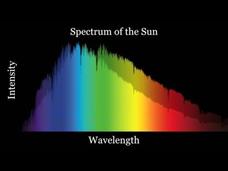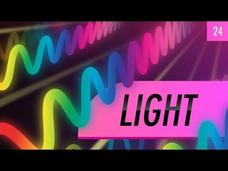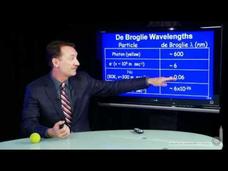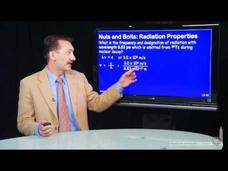Physics Girl
What Is Color?
If your electromagnetic spectrum lesson plan has you feeling a little blue, here's a resource that will have you tickled pink! A video from a vast physics playlist describes color from its humble beginnings as a wavelength to its...
Physics Girl
Seeing the Smallest Thing in the Universe
How do we see what we can't see? An episode of a comprehensive physics playlist shows images of the smallest particles current technology can record. The instructor discusses current and past research on the makeup of subatomic particles.
Physics Girl
Does This Look White to You?
Explore the difference between the two color wheels. The focus of the installment of a larger physics playlist is to explain the difference between mixing colored paints and colored lights. Viewers find that the components of their eyes...
American Chemical Society
The Chemistry of Fireworks
Experiment with chemical compounds to produce the colors in fireworks! The lesson instructor demonstrates how adding high temperatures to specific compounds creates a colorful reaction—the same one people use to create fireworks. This is...
American Chemical Society
What is the Blackest Black?
Is there really more than one black? Although your crayon box may tell you otherwise, some blacks are, well, blacker than others! Discover the cutting-edge technology at work to produce the blackest black possible with a video from the...
Veritasium
Why the Sky ISN'T Blue
The answer is: a method to celebrate a major milestone. A proud video celebrates 500,000 followers and gives an idea of how big that number is. The resource in the Veritasium playlist goes on to answer several questions posed by...
Veritasium
How Do Chameleons Change Color?
Talk about weird science! Young biologists discover the amazing structures found in the skin of male chameleons during a video from Veritasium. The narrator discusses common myths about chameleon color change, what triggers the...
THNKR
Bill Nye Searches For Water On Jupiter
How can researchers measure the amount of water on Jupiter? Through a thought-provoking THNKR "Why with Nye!" video, young space scientists search for the universal solvent on a distant planet. Topics include how scientists use visible...
Bozeman Science
PS4A - Wave Properties
Does your lesson plan for wave properties have its ups and downs? Get some fresh ideas from an informative video! The narrator discusses PS4A, showing the must-know ideas for each grade level through concept maps and demonstrations.
Crash Course
Traveling Waves: Crash Course Physics #17
Explore transverse and longitudinal waves through a video lesson. Building on the previous lesson in the Crash Course physics series, the 17th lesson compares and contrasts transverse and longitudinal waves. The narrator includes a...
MinuteEarth
Transparent Solar Panels?!
Coming soon to a windowpane near you, a solar panel you can see through! Science scholars discover new solar technology in a short video. The narrator compares the dark, traditional solar panel with the recently developed clear version...
Crash Course
Light
All this talk about seeing the light... but, what is it, and how do we see it? Science students learn the basics of the nature of light in a narrated video that discusses concepts such as how light behaves, the electromagnetic...
Bozeman Science
Waves
Calculating frequency is so easy it Hertz! The video begins by describing transverse and longitudinal waves, and then it explores their properties and applications. Finally, it applies this to the formulaic relationships between wave...
TED-Ed
Does This Look White to You?
Believe it or not, the light color wheel and the paint color wheel are not the same. Physics Girl explains how computer screens trick viewers into seeing colors that are not actually present (Hint: It's cones versus wavelengths).
DoodleScience
Transverse and Longitudinal Waves
Transverse waves and longitudinal waves each have unique properties. Young scholars learn these differences, the measurements of waves, and a formula for calculating the speed of the wave.
Be Smart
What Color is the Universe?
What colors are the sun, our galaxy, and the universe? An engaging video provides an overview of each and why what we think we are seeing is often wrong. It provides explanations for how to understand colors that aren't in the...
Berkeley University of California
De Broglie Wavelengths
You learned in the previous lesson in this series that a particle with momentum has the properties of a wave. So how about a baseball? The lesson calculates the wavelengths of different particles given their momentum (mass and velocity),...
Berkeley University of California
Hydrogen Atom as a Particle in a Box (NB)
How does an electron qualify as a particle in a box? It behaves like a wave and, when bound to an atom, has boundaries. Using this notion, the professor explains a quantum mechanical calculation for a hydrogen atom. Given the length of...
Berkeley University of California
Photoelectrons
How much energy does it take for an electron jump from chromium metal? Using a formula, the instructor describes the procedure for determining the wavelength of light needed for a specific metal to eject electrons.
Berkeley University of California
Light Wave-Particle Duality
How can light be both a wave and particle? A video explains the co-existing wave and particle nature of light. Using formulas discussed in previous lessons in the series, the instructor develops the formula that shows the...
Berkeley University of California
Radiation Properties
How are the wavelength, frequency, and speed of a wave related? The instructor in the video explains the process of determining the frequency of a wave with a known speed and wavelength. The wave is then classified along the...
TED-Ed
What is the Heisenberg Uncertainty Principle?
Not sure how to introduce young physicists to the Heisenberg Uncertainty Principal? Well this short video is a great place to start, as it explains how the particle and wave nature of matter makes it impossible to know both the...
Curated OER
Waves
The nature of waves is revealed through a tank of water and computer animations. Your physics learners will be illuminated by viewing this explanatory video.
Curated OER
Refraction
Refraction is the bending of light, changing its path. This phenomenon is caused by a change in the speed of the light waves. This video provides visual demonstrations of refraction through various media. It concludes by mentioning how...























